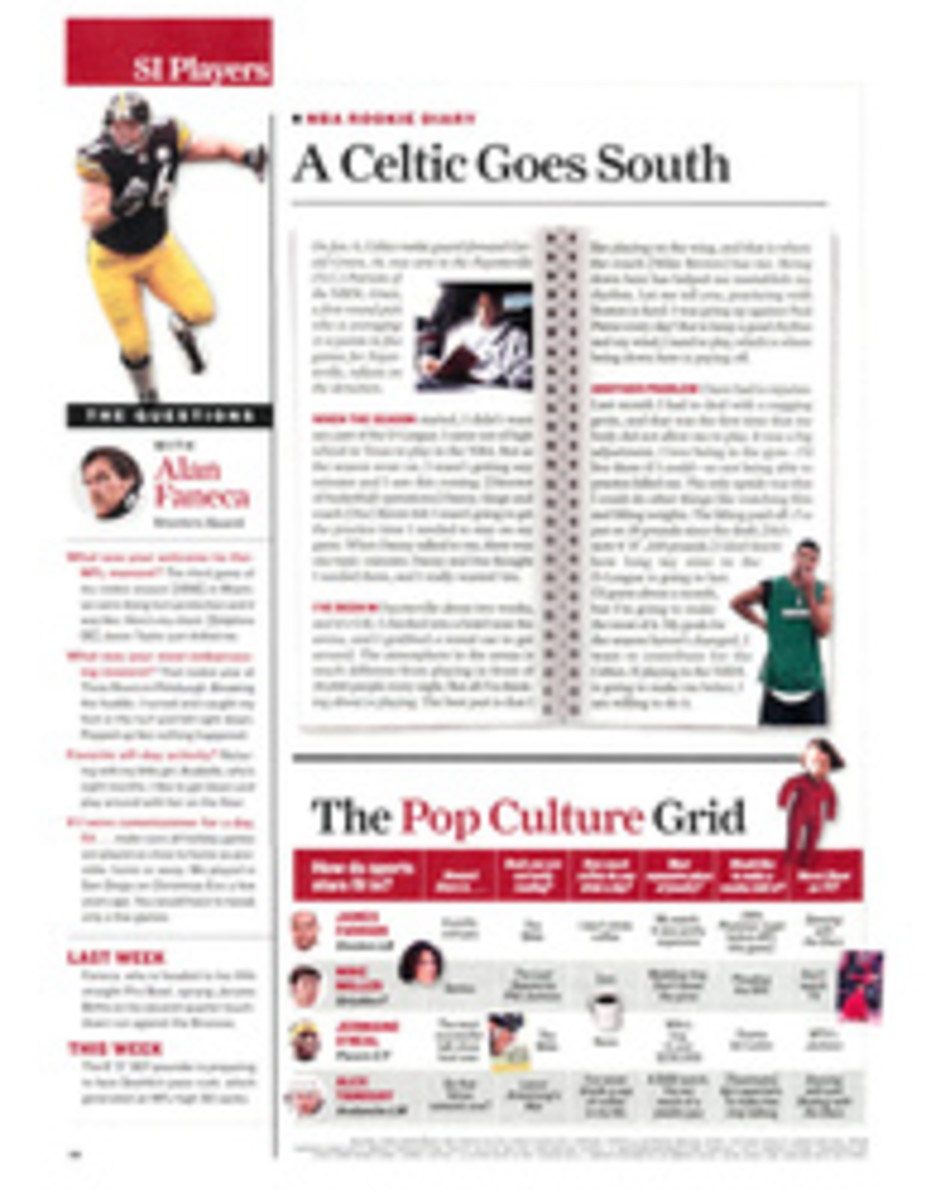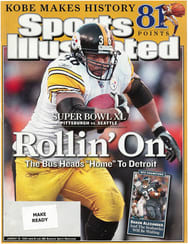
The Man Who Changed Hockey
Comfortably ensconced in a private dining room in Calgary not long ago, the Detroit Red Wings were watching an NHL game on a giant-screen television when the referee raised his arm to make what struck the Wings as a phantom call. All heads in the room swiveled in the direction of forward Brendan Shanahan, who at that moment might as well have had a whistle in his mouth instead of the taste of dinner. His teammates pointed at him. Then, in chorus, they began to boo. "What?" Shanahan protested. "What?" ¶ A year after organizing a conference of hockey's movers and shakers that laid the groundwork for the most stunning remake of a professional sports league in memory--a rules overhaul that most players embrace but that has some complaining about the increase in penalty calls--what did he expect? That phantom call was on him. ¶ The lockout was an important year for the 37-year-old Shanahan because it afforded him a chance to "glimpse behind the door of life after hockey," even while he was preparing to play again. He put his children to bed every night and spent more quality time with his wife, Catherine, but perhaps the most impactful thing he did during that unscheduled sabbatical was put together a two-day meeting at a Toronto hotel in December 2004. It's now widely known now as the Shanahan Summit, which hints at something more august than 26 guests (players, coaches, general managers, owners, agents, television executives) brainstorming about the NHL. Shanahan deflects credit to commissioner Gary Bettman, NHL director of hockey operations Colin Campbell and former Players Association executive director Bob Goodenow (all of whom supported the meeting), but Shanahan was the one who extended the invitations ("I felt embarrassed calling, like I was a salesman," he says), and he was the one who footed the bill.
At a time when management and labor were barely talking at each other let alone to each other, his conference illuminated the dark season. Based on the consensus reached in Toronto, Shanahan outlined numerous proposed rules changes and took his wish list to Bettman and Goodenow, in separate face-to-face meetings. By the time the NHL returned last fall, the league had instituted sweeping changes that included more vigilant officiating, adding the shootout, allowing the two-line pass, disallowing line changes for the team that ices the puck, setting limits on the size of goalie equipment and creating a competition committee that has active players on it. The new rules have greatly enlivened the game--and virtually all of them were the product of the Shanahan Summit.
"He put a lot on the line," Detroit forward Kris Draper says. "Shanny stepped up when nothing was going on, not that we don't give him heat about it." If insults are the lingua franca of the dressing room, the Red Wings are among the most loquacious of teams. "Doing a story on the savior? The messiah?" asked captain Steve Yzerman through a tight-lipped grin, as Western Conference--leading Detroit checked into a Denver hotel last Thursday. Like NHL referees in 2005-06, the Wings don't let much go--certainly not a year-end story in Toronto's Globe and Mail that named Shanahan the most influential person in Canadian sports, nor his No. 10 spot in The Hockey News ranking of people of power and influence in the game.
Well on the back nine of a career that through Sunday had produced 580 goals (including 99 game-winners), 2,329 penalty minutes, three Stanley Cups and an Olympic gold medal, Shanahan shook his head when told he might best be remembered for chairing a conference. "I hear that," he says, "and I think, Dummy!" The men who previously changed hockey--Jacques Plante popularizing the goalie mask, Bobby Orr rushing the puck, Wayne Gretzky dishing from behind the net--did it because of a peculiar on-ice genius, something beyond Shanahan's humbler gifts. "You watch my game and nothing jumps out," he says. "I'm the tortoise in the fable." So he left his indelible mark while wearing a snazzy black suit, not the winged-wheel sweater.
"You sit around with guys after a game, and you hear all these ideas how to make things better," Shanahan says. "Then you wake up the next day, and it's forgotten. I started thinking about [organizing a meeting] after the [November 2004] Hall of Fame induction of Ray Bourque, Paul Coffey and Larry Murphy. I read comments Coffey made [decrying] the state of the game. So I thought maybe we should all talk about it. I called one player and one agent and asked if a meeting like this could ever happen. They both told me no. So I went ahead and tried to do it."
Though Shanahan bridles at the notion that the NHL's revival has mirrored his own--"If this is a rebirth," he says, "when did I die?"--there is undeniably an added zest to his play. After scoring 25 goals in 2003-04, 14 below his average over the previous 10 full seasons, Shanahan was tied for the team lead with 22 at week's end, making him one of only nine NHL players to score 20 or more goals in each of 17 seasons. "He made the rules; he better be playing better," says Detroit goaltender Manny Legace, laughing. "He seems more energized. He's eager to play, eager to practice. He's one of only a couple of guys I've seen who work on their total game in practice. He's always asking me if a goalie comes across [the crease] a certain way, where's the best spot to put the puck. It's impressive the way he thinks about the game."
The player who midwifed changes in the game finally made some himself. He abandoned his Antiques Roadshow two-piece stick for a newfangled composite. He traded in his circa 1991-model skates for a pair three pounds lighter. He updated his shoulder pads, going to less bulky ones. He also landed a new role on the NHL's leading power play, moving from his shooter's spot along the left half boards to outside the crease. Coach Mike Babcock uses the clever Robert Lang on the half wall on the second power-play unit, Shanahan in traffic.
If Yzerman remains the pride of the Wings in his presumptive final season in Detroit, then Babcock is the prod of the Wings in his first. Babcock's hectoring has invited some comparisons to Hall of Fame coach Scotty Bowman, a grumbled sort of flattery. Like Bowman, who used to ride Shanahan like a $6,000 claimer, Babcock can be harsh on Shanahan, constantly reminding him to skate hard and move his feet. "He told me in training camp that I'd have a great year and he'd be in my ear the whole time," Shanahan says. "Well, he's been in my ear. His voice can be like sandpaper to me, which is kind of good because I take it out on the ice with me. He came up to me one night and said, 'We really need you going big tonight. How do I tick you off?' I said, 'You just did.'"
"From coaching against him [with Anaheim], I thought he should have been a way bigger factor than he was [in 2003-04]," Babcock says of Shanahan. "He has [attributes] other people don't. He has the size [6'3", 220 pounds] and the ability to make plays in tight. I thought that if I could get him to skate and be physical, we'd be better off. My image of Shanny the past few years is he'd be coming down the ice and opening up for a one-timer and someone would get him the puck"--think Brett Hull Lite--"but that's not how I want us to play. I want us to be a driving, playoff-goal-scoring team from Game 1 to 82. We want rebound goals. Crease goals. Those pretty goals you see in October and November? You don't score those in the playoffs. If you go through Shanny's goals this season, he's scored some big ones on nice shots, but more have come from going hard to the net."
Because the Red Wings play in the porridge-soft Central Division, with 10 games left against Chicago, Columbus and St. Louis, they can already start preparing for the playoffs. Babcock calls the final 35 matches of the season "a dress rehearsal," and last Saturday the Colorado Avalanche and Detroit certainly remembered their lines. The sanctioned mayhem that marked games between the two best teams of the past decade has dissipated--the crowd didn't muster an anti-Wings chant until midway through the second period--but there were enough postwhistle scrums and intensity that it was all vaguely and pleasantly familiar, like a whiff of an old girlfriend's brand of perfume in an elevator.
In the end, of course, this was postsummit hockey: three 5-on-3 power plays--Detroit defenseman Chris Chelios avowed afterward that NBC was leaning on refs to "control the game," to create scoring opportunities and keep the score close--and a late Red Wings penalty that was an indirect result of the new rule that curtails goalie puckhandling. With the puck slowly rimming the boards and an Avalanche forward giving chase, Legace had to remain in net, forbidden from going out to play the puck. That forced the scrambling Detroit defense to take a holding penalty with fewer than four minutes left.
But buoyed by the superb center Pavel Datsyuk, who had scored in the first minute on a Shanahan feed--"Shanny's there to keep the flies off Datsyuk," Babcock says--and attentive defense in the third period, Detroit held on for a 4-3 win, moving five points clear of the Nashville Predators, their closest pursuers in the West. Like Shanahan, the Wings were at the summit.
SI.COM
For more NHL coverage, and more from Michael Farber, go to SI.com/hockey.
Tough Scorers
Brendan Shanahan is the only active NHLer with more than 500 goals and 2,000 penalty minutes. He also has the most seasons with 30 goals and 100 penalty minutes in history (below). With 22 goals and 56 minutes through Sunday, he's on his way to another.
PLAYER (NHL CAREER)     /     SEASONS WITH 30 GOALS, 100 PENALTY MINUTES
Brendan Shanahan (1987-88 to present) 10
Keith Tkachuk (1991-92 to present) 8
Pat Verbeek (1982-83 to 2001-02) 8
Eric Lindros (1992-93 to present) 7
Rick Vaive (1979-80 to '91-92) 7
Theo Fleury (1988-89 to 2002-03) 6
Paul MacLean (1980-81 to '90-91) 6
Brian Sutter (1976-77 to '87-88) 6
PHOTO
Photograph by David E. Klutho
PHOTO
DAVID E. KLUTHO (BABCOCK)
TOUGH LOVE First-year coach Babcock gave Shanahan a new power-play role, and has bullied the winger back into top form.
PHOTO
GREGORY SHAMUS/GETTY IMAGES (SHANAHAN FIGHTING)

